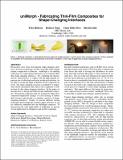uniMorph: Fabricating Thin Film Composites for Shape-Changing Interfaces
Author(s)
Heibeck, Felix; Tome, Basheer; Della Silva, Clark D.; Ishii, Hiroshi
DownloadIshii_Unimorph.pdf (7.467Mb)
OPEN_ACCESS_POLICY
Open Access Policy
Creative Commons Attribution-Noncommercial-Share Alike
Terms of use
Metadata
Show full item recordAbstract
Researchers have been investigating shape-changing interfaces, however technologies for thin, reversible shape change remain complicated to fabricate. uniMorph is an enabling technology for rapid digital fabrication of customized thin-film shape-changing interfaces. By combining the thermoelectric characteristics of copper with the high thermal expansion rate of ultra-high molecular weight polyethylene, we are able to actuate the shape of flexible circuit composites directly. The shape-changing actuation is enabled by a temperature driven mechanism and reduces the complexity of fabrication for thin shape-changing interfaces. In this paper we describe how to design and fabricate thin uniMorph composites. We present composites that are actuated by either environmental temperature changes or active heating of embedded structures and provide a systematic overview of shape-changing primitives. Finally, we present different sensing techniques that leverage the existing copper structures or can be seamlessly embedded into the uniMorph composite. To demonstrate the wide applicability of uniMorph, we present several applications in ubiquitous and mobile computing.
Date issued
2015-11Department
Massachusetts Institute of Technology. Department of Electrical Engineering and Computer Science; Massachusetts Institute of Technology. Media Laboratory; Program in Media Arts and Sciences (Massachusetts Institute of Technology)Journal
Proceedings of the 28th Annual ACM Symposium on User Interface Software & Technology - UIST '15 Adjunct
Publisher
Association for Computing Machinery
Citation
Heibeck, Felix et al. “uniMorph: Fabricating Thin Film Composites for Shape-Changing Interfaces.” ACM Press, 2015. 233–242.
Version: Author's final manuscript
ISSN
978-1-4503-3780-9